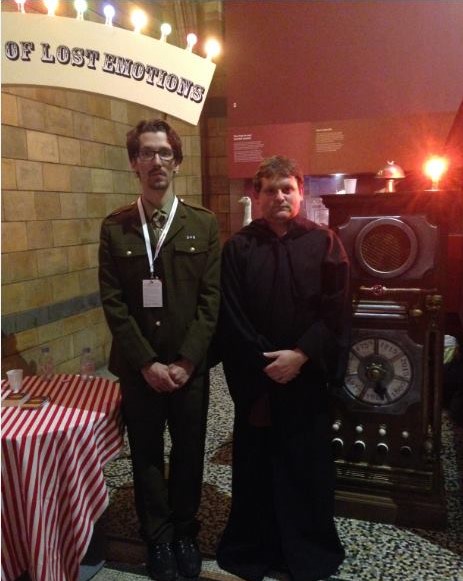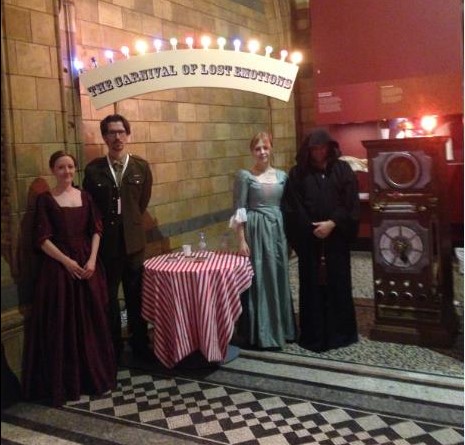Eleanor Betts is a PhD candidate in the School of History at Queen Mary, University of London, researching Victorian responses to children who killed. Eleanor also writes a National Trust blog about the lives of servants in Ickworth House in 1935. You can follow her on Twitter @BettsEleanor.
Eleanor was part of the team involved in the most recent outing of the Centre for the History of the Emotions’s ‘Lost Emotions’ Machine – an experience which she reflects upon in this post..
“Roll Up Roll Up, Come and Experience the Carnival of Lost Emotions and Be Prepared to Be Amazed…”
In June 2014, the Carnival of Lost Emotions returned for a sixth run. Visitors to Universities Week, part of the Late Night events hosted at the Natural History Museum, were able to experience for themselves emotions of the past. Dr Chris Millard, Rebecca O’Neal, Richard Firth-Godbehere and Eleanor Betts donned the clothes of our ancestors and introduced members of the public to the Lost Emotions Machine. With a spin of a dial to locate a certain date, a few clicks of a switch, and the manoeuvring of levers – ‘hey presto’ a lost emotion appeared. These included frenzy, accedia, melancholy, incubus, hypochondriasis, moral insanity, shell shock, and oxytocin. All of these past emotional states might include symptoms that are familiar to us today, but underneath the apparent similarities there is a world of difference in how the people of the past recognised and understood feelings we now term ‘emotions’.
Under the shadow of the great Diplodocus in the main hall of the museum visitors found out that emotions are not universal or eternal. They are in flux and are influenced by the social and cultural context in which they are experienced. For instance the lost emotions accedia and shell shock were geographically dependent; accedia on medieval monasteries and shell shock on early twentieth-century battlefields.
Accedia was an emotion suffered by monks in the Middle Ages, an emotional state intrinsically attached to the geographical and architectural designs of a monastery. It followed spiritual crisis and involved severe bouts of despair, tiredness, sloth, and distaste for the monastic life. Though the symptoms might sound like those of clinical depression the monks of the Middle Ages did not understand or explain their feelings in the same way we do now. They did not have the scientific knowledge, or language based on this knowledge, that we have today. Emotional states were understood in spiritual terms. Accedia was the result of a loss of faith, an emotion that should be endured almost as a self-inflicted punishment.
Charles Darwin’s statue sat at the top of the grand staircase in the main hall and watched as the Carnival of Lost Emotions displayed how an individual’s experience of an emotional state is determined by the environment in which they live. Emotions, and how we understand emotional states, adapt according to social, economic, political, and cultural change. For instance how is, and how was, love understood? In recent years it has been argued that the chemical, oxytocin, produces the feelings we associate with the emotion ‘love’. Increased levels of this hormone are found in newly partnered couples and oxytocin is believed to induce feelings of trust and affection between mothers who breastfeed babies. Before our knowledge of neuroscience, though the sensations of certain feelings might have been similar as they are today, love was not understood as a chemical reaction and was expressed in many different ways. A medieval form of love was devotio. This was the love of Jesus and focused on the Passion of Christ. This form of love was all-consuming and was often expressed in the infliction of self-pain – to share in Christ’s suffering. This might not be the form of love we are familiar with, but it was very real and very important to ordinary people in the Middle Ages.
Notions of familial love have also varied throughout history. In the early modern period, for instance, the love of a child in a family of puritans was best expressed by a strict parent. Love of God was the love that guided a person, and it was believed that cosseting a child would not instil that love of God in them. Things began to change, however, with the rise of sensibility in the eighteenth and nineteenth centuries. Here the love of a child was best expressed with compassion and affection – the form of love we recognise more today.
The Carnival of Lost Emotions also exposed how notions of ‘right’ and ‘wrong’ emotions have changed over time. For example there were certain forms of anger that were acceptable to express in public before the nineteenth century. Duelling between the male elite was not an uncommon occurrence and in the Middle Ages a certain degree of anger was considered to be a necessary part of chivalry. Furthermore in the nineteenth century if a husband argued that he killed his wife because she had been having an affair the emotion of jealousy was accepted as a mitigating circumstance. This seems absurd to us today, but it was perfectly understandable in a society that exercised a number of double standards.
So what does this all mean? Why invite members of the public to experience lost emotions of the past? This approach to history allows historians to consider how individual people understood themselves in the past, as individuals and as part of the community in which they lived. If we recognise that a fixed number of emotions have not existed since the beginning of time, and that emotional states are not felt and understood in the same way (both in the past and in different cultural communities) then we can understand more about who we are and who we were. We are not mere machines controlled by a set programme of emotional states. We find it hard enough today to express how we feel and understand where we belong in the big wide world. Why assume that it was any simpler in the past? This adds a new level to the study of history, and the public who experienced the Carnival of Lost Emotions last week seemed to go away feeling satisfied that emotions in the past could be very different from how we understand them today.
Click here to read more about the Carnival of Lost Emotions and watch a short video.



